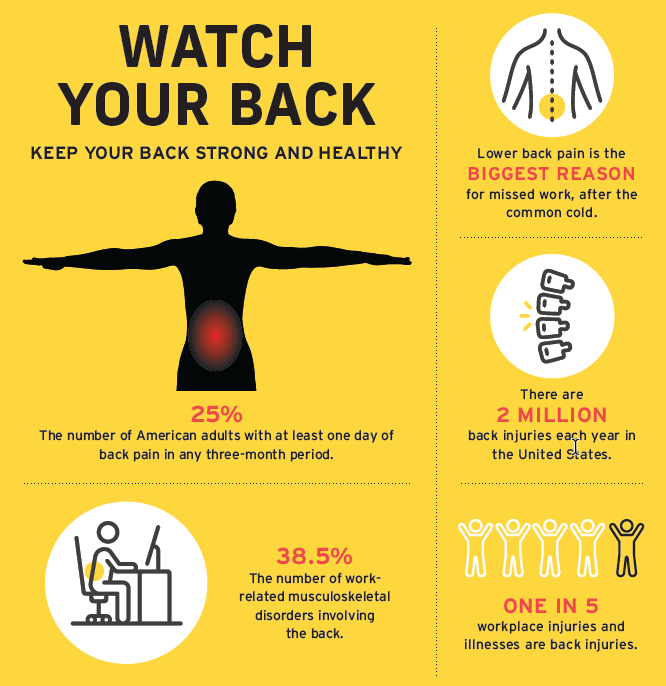Live Well
Watch Your Back

Watch Your Back
Keep your back strong and healthy
When you want to tell people you’re there for them, you say, “I’ve got your back.” But who’s got your back? Make sure it stays strong and healthy by using good lifting techniques and maintaining proper posture. If you and your doctor have decided opioids are a good option for dealing with your back pain, take the medications with great care. Follow your doctor’s instructions closely.
Proper lifting
A 2016 study by the Bureau of Labor Statistics revealed the top causes of work-related musculoskeletal disorders resulting in missed work. At 38.5 percent, the leading cause by far was back injuries. This is true across jobs, for everyone from nursing assistants to truck drivers. Take extra care to prevent back injuries at work. Here are some tips to help you safely lift or move a heavy object:
- Start by making a plan. Make sure you understand where you’re going, and be sure you have a clear path.
- Hold the item close to your body for added stability.
- Keep your feet shoulder-width apart for a solid base.
- Maintain proper form. Keep your back straight, bend your knees and tighten your stomach muscles.
- Lift with your legs.
- Get help if an object is too heavy or awkward.
Proper posture
Poor posture can cause a variety of health problems. These include:
- Neck, shoulder and back pain.
- Decreased flexibility.
- Greater likelihood of spinal injury.
- A misaligned musculoskeletal system.
- Poor balance and increased risk of falls.
- Digestion problems.
Get in the habit of paying attention to your posture, no matter what you’re doing. If you’re sitting, relax your shoulders and keep both feet flat on the floor. Take periodic breaks to walk around or stretch lightly. If you’re standing, keep your shoulders back and your head level. Pull in your stomach, keep your weight mostly on the balls of your feet, and stand straight and tall.
Use of imaging tests
Back pain usually improves on its own within about a month. For this reason, experts generally do not recommend imaging tests for back pain. These tests, such as X-rays, CT scans and MRIs, take pictures of the inside of your body. They are costly and can sometimes lead to unnecessary treatments, like surgery.
Opioid use
Opioids are strong medications that can cause long-term dependency, possibly leading to addiction. According to the Mayo Clinic, you should work closely with your care provider to carefully decide whether opioids are right for your back pain. Talk to your doctor about your family history, medical history and your personal history of substance abuse. These factors will help your doctor decide whether opioids are safe for you to try.
Your doctor will ask you to sign an agreement before you begin a long-term course of these medications. This agreement spells out your responsibilities while using prescription opioids:
- Use opioids only as prescribed.
- Get opioids from only one physician and one pharmacy.
- Acknowledge you won’t receive additional medication until your current prescription runs out.
- Submit to periodic urine tests and pill counts if your doctor requests them.
- Follow all aspects of your treatment plan and see your care team as directed.
Follow these guidelines closely if you’re using opioids, and make sure your doctor and pharmacist are aware of all the drugs you are taking. Opioids can interact dangerously with other medications — even over-the-counter drugs. Closely review the instructions and warnings you receive with your prescription. Make sure you understand how the medication might affect you.
You should also be aware of the side effects the medication could have. Tell your doctor right away if you experience any side effects. Never take expired drugs. Dispose of them safely; contact your local police department or garbage pickup service for advice. When it’s time to stop taking the medication, work with your doctor to do so safely. Don’t try to go it alone.
Prevent back injuries before they happen. If you do hurt your back, work closely with your doctor to find the pain management solution that will work best for you.
*The Mayo Clinic is an independent organization that offers health information you may find helpful.
Article sources:
https://www.bls.gov/opub/ted/2018/back-injuries-prominent-in-work-related-musculoskeletal-disorder-cases-in-2016.htm?view_full
https://www.verywellhealth.com/how-to-lift-2548509
https://medlineplus.gov/guidetogoodposture.html
https://www.choosingwisely.org/patient-resources/imaging-tests-for-back-pain/
*Statistics and information are accurate as of the time of publication and may change over time.
